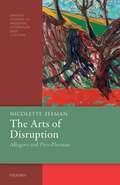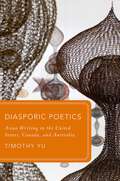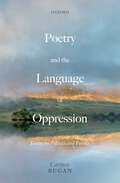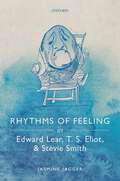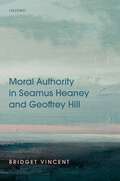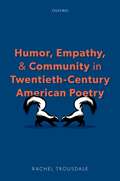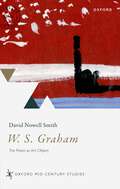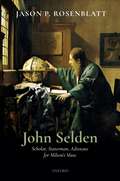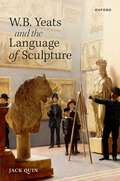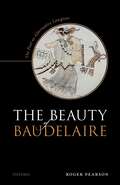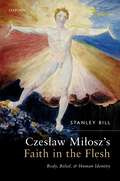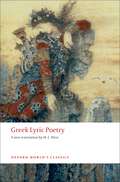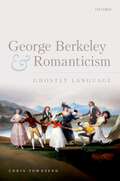- Table View
- List View
The Arts of Disruption: Allegory and Piers Plowman (Oxford Studies in Medieval Literature and Culture)
by Nicolette ZeemanThe monograph series Oxford Studies in Medieval Literature and Culture showcases the plurilingual and multicultural quality of medieval literature and actively seeks to promote research that not only focuses on the array of subjects medievalists now pursue - in literature, theology, and philosophy, in social, political, jurisprudential, and intellectual history, the history of art, and the history of science - but also that combines these subjects productively. It offers innovative studies on topics that may include, but are not limited to, manuscript and book history; languages and literatures of the global Middle Ages; race and the post-colonial; the digital humanities, media and performance; music; medicine; the history of affect and the emotions; the literature and practices of devotion; the theory and history of gender and sexuality, ecocriticism and the environment; theories of aesthetics; medievalism. The Arts of Disruption: Allegory and Piers Plowman offers a series of new readings of the allegorical poem Piers Plowman: but it is also a book about allegory. It argues not just that there are distinctively disruptive 'arts' that occur in allegory, but that allegory, because it is interested in the difficulty of making meaning, is itself a disruptive art. The book approaches this topic via the study of five medieval allegorical narrative structures that exploit diegetic conflict and disruption. Although very different, they all bring together contrasting descriptions of spiritual process, in order to develop new understanding and excite moral or devotional change. These five structures are: the paradiastolic 'hypocritical figure' (such as vices masked by being made to look like 'adjacent' virtues), personification debate, violent language and gestures of apophasis, narratives of bodily decline, and grail romance. Each appears in a range of texts, which the book explores, along with other connected materials in medieval rhetoric, logic, grammar, spiritual thought, ethics, medicine, and romance iconography. These allegorical narrative structures appear radically transformed in Piers Plowman, where the poem makes further meaning out of the friction between them. Much of the allegorical work of the poem occurs at the points of their intersection, and within the conceptual gaps that open up between them. Ranging across a wide variety of medieval allegorical texts, the book shows from many perspectives allegory's juxtaposition of the heterogeneous and its questioning of supposed continuities.
The Arts of Disruption: Allegory and Piers Plowman (Oxford Studies in Medieval Literature and Culture)
by Nicolette ZeemanThe monograph series Oxford Studies in Medieval Literature and Culture showcases the plurilingual and multicultural quality of medieval literature and actively seeks to promote research that not only focuses on the array of subjects medievalists now pursue - in literature, theology, and philosophy, in social, political, jurisprudential, and intellectual history, the history of art, and the history of science - but also that combines these subjects productively. It offers innovative studies on topics that may include, but are not limited to, manuscript and book history; languages and literatures of the global Middle Ages; race and the post-colonial; the digital humanities, media and performance; music; medicine; the history of affect and the emotions; the literature and practices of devotion; the theory and history of gender and sexuality, ecocriticism and the environment; theories of aesthetics; medievalism. The Arts of Disruption: Allegory and Piers Plowman offers a series of new readings of the allegorical poem Piers Plowman: but it is also a book about allegory. It argues not just that there are distinctively disruptive 'arts' that occur in allegory, but that allegory, because it is interested in the difficulty of making meaning, is itself a disruptive art. The book approaches this topic via the study of five medieval allegorical narrative structures that exploit diegetic conflict and disruption. Although very different, they all bring together contrasting descriptions of spiritual process, in order to develop new understanding and excite moral or devotional change. These five structures are: the paradiastolic 'hypocritical figure' (such as vices masked by being made to look like 'adjacent' virtues), personification debate, violent language and gestures of apophasis, narratives of bodily decline, and grail romance. Each appears in a range of texts, which the book explores, along with other connected materials in medieval rhetoric, logic, grammar, spiritual thought, ethics, medicine, and romance iconography. These allegorical narrative structures appear radically transformed in Piers Plowman, where the poem makes further meaning out of the friction between them. Much of the allegorical work of the poem occurs at the points of their intersection, and within the conceptual gaps that open up between them. Ranging across a wide variety of medieval allegorical texts, the book shows from many perspectives allegory's juxtaposition of the heterogeneous and its questioning of supposed continuities.
Diasporic Poetics: Asian Writing in the United States, Canada, and Australia (Global Asias)
by Timothy YuThis book advances a new concept of the "Asian diaspora" that creates links between Asian American, Asian Canadian, and Asian Australian identities. Drawing from comparable studies of the black diaspora, it traces the histories of colonialism, immigration, and exclusion shared by these three populations. The work of Asian poets in each of these three countries offers a rich terrain for understanding how Asian identities emerge at the intersection of national and transnational flows, with the poets' thematic and formal choices reflecting the varied pressures of social and cultural histories, as well as the influence of Asian writers in other national locations. Diasporic Poetics argues that racialized and nationally bounded "Asian" identities often emerge from transnational political solidarities, from "Third World" struggles against colonialism to the global influence of the American civil rights movement. Indeed, this volume shows that Asian writers disclaim national belonging as often as they claim it, placing Asian diasporic writers at a critical distance from the national spaces within which they write. As the first full-length study to compare Asian American, Asian Canadian, and Asian Australian writers, the book offers the historical and cultural contexts necessary to understand the distinctive development of Asian writing in each country, while also offering close analysis of the work of writers such as Janice Mirikitani, Fred Wah, Ouyang Yu, Myung Mi Kim, and Cathy Park Hong.
Diasporic Poetics: Asian Writing in the United States, Canada, and Australia (Global Asias)
by Timothy YuThis book advances a new concept of the "Asian diaspora" that creates links between Asian American, Asian Canadian, and Asian Australian identities. Drawing from comparable studies of the black diaspora, it traces the histories of colonialism, immigration, and exclusion shared by these three populations. The work of Asian poets in each of these three countries offers a rich terrain for understanding how Asian identities emerge at the intersection of national and transnational flows, with the poets' thematic and formal choices reflecting the varied pressures of social and cultural histories, as well as the influence of Asian writers in other national locations. Diasporic Poetics argues that racialized and nationally bounded "Asian" identities often emerge from transnational political solidarities, from "Third World" struggles against colonialism to the global influence of the American civil rights movement. Indeed, this volume shows that Asian writers disclaim national belonging as often as they claim it, placing Asian diasporic writers at a critical distance from the national spaces within which they write. As the first full-length study to compare Asian American, Asian Canadian, and Asian Australian writers, the book offers the historical and cultural contexts necessary to understand the distinctive development of Asian writing in each country, while also offering close analysis of the work of writers such as Janice Mirikitani, Fred Wah, Ouyang Yu, Myung Mi Kim, and Cathy Park Hong.
Poetry and the Language of Oppression: Essays on Politics and Poetics
by Carmen BuganA first-hand account of the creative process that engages with the language of oppression and with politics in our time. How does the poet become attuned to the language of the world's upheaval? How does one talk insightfully about suffering, without creating more of it? What is freedom in language and how does the poet who has endured political oppression write himself or herself free? What is literary testimony? Poetry and the Language of Oppression is a consideration of the creative process that rests on the conviction that poetry is of help in moments of public duress, providing an illumination of life and a healing language. Oppression, repression, expression, as well as their tools (prison, surveillance, gestures in language) have been with us in various forms throughout history, and this volume represents a particular aspect of these conditions of our humanity as they play out in our time, providing another instance of the communion, and sometimes confrontation, with the language that makes us human.
Poetry and the Language of Oppression: Essays on Politics and Poetics
by Carmen BuganA first-hand account of the creative process that engages with the language of oppression and with politics in our time. How does the poet become attuned to the language of the world's upheaval? How does one talk insightfully about suffering, without creating more of it? What is freedom in language and how does the poet who has endured political oppression write himself or herself free? What is literary testimony? Poetry and the Language of Oppression is a consideration of the creative process that rests on the conviction that poetry is of help in moments of public duress, providing an illumination of life and a healing language. Oppression, repression, expression, as well as their tools (prison, surveillance, gestures in language) have been with us in various forms throughout history, and this volume represents a particular aspect of these conditions of our humanity as they play out in our time, providing another instance of the communion, and sometimes confrontation, with the language that makes us human.
Rhythms of Feeling in Edward Lear, T. S. Eliot, and Stevie Smith
by Jasmine JaggerRich with unpublished material and detailed insight, Rhythms of Feeling offers a new reading of three of the most celebrated poets: Edward Lear, T.S. Eliot, and Stevie Smith. Tracing exciting lines of interplay, affinity, and influence between these writers for the first time, the book shifts the terms of critical debate on Lear, Eliot, and Smith and subtly reorients the traditional account of the genealogies of Modernism. Going beyond a biographically-framed close reading or a more general analysis framed by affect theory, the volume traces these poets' 'affective rhythms' (fits, tears, nerves) to consider the way that poetics, the mental and physical process of writing and reading, and the ebbs and flows of their emotional weather might be in dialogue. Attentive, acute, and often forensic, the book broadens its reach to contemporary writers and medical accounts of creativity and cognition. Alongside deep critical study, this volume seeks to bring emotional intelligence to criticism, finding ways of speaking lucidly and humanely about emotional and physical states that defy lucidity and stretch our sense of the human.
Rhythms of Feeling in Edward Lear, T. S. Eliot, and Stevie Smith
by Jasmine JaggerRich with unpublished material and detailed insight, Rhythms of Feeling offers a new reading of three of the most celebrated poets: Edward Lear, T.S. Eliot, and Stevie Smith. Tracing exciting lines of interplay, affinity, and influence between these writers for the first time, the book shifts the terms of critical debate on Lear, Eliot, and Smith and subtly reorients the traditional account of the genealogies of Modernism. Going beyond a biographically-framed close reading or a more general analysis framed by affect theory, the volume traces these poets' 'affective rhythms' (fits, tears, nerves) to consider the way that poetics, the mental and physical process of writing and reading, and the ebbs and flows of their emotional weather might be in dialogue. Attentive, acute, and often forensic, the book broadens its reach to contemporary writers and medical accounts of creativity and cognition. Alongside deep critical study, this volume seeks to bring emotional intelligence to criticism, finding ways of speaking lucidly and humanely about emotional and physical states that defy lucidity and stretch our sense of the human.
Moral Authority in Seamus Heaney and Geoffrey Hill
by Bridget VincentHow do poems communicate moral ideas? Can they express concepts in ways that are unique and impossible to replicate in other forms of writing? This book explores these questions by turning to two of the late twentieth century's most important poets: Seamus Heaney and Geoffrey Hill. Their work shows that a poem can act as an example of a moral concept, rather than simply a description or discussion of it. Exploring these two poets via their shared preoccupation with poetry's moral exemplarity opens up new perspectives on their work. The concept of exemplarity is shown to play an important role in these poets' most significant preoccupations, from moral complicity to the nature of lyric speech to literary influence to memorialisation, responsibility, and aesthetic autonomy. Through this new analysis of poetry, critical prose, drama, and archival materials, this book offers a major new study of ethics in the later period of these two writers—including recent underexplored posthumous works. In turn, the book also makes an important intervention in larger debates about literature and morality, and about the field of ethical criticism itself: this is the first book-length study to expand ethical criticism beyond its customary narrative focus. The ethical criticism of fiction is often an exercise in methodological advocacy, urging the use of more literary examples in moral philosophy. As this book shows, including poetry among these examples introduces new, lyric-inflected caveats about the use of literature as a form of moral example: caveats which remain invisible in narrative-centred ethical criticism.
Moral Authority in Seamus Heaney and Geoffrey Hill
by Bridget VincentHow do poems communicate moral ideas? Can they express concepts in ways that are unique and impossible to replicate in other forms of writing? This book explores these questions by turning to two of the late twentieth century's most important poets: Seamus Heaney and Geoffrey Hill. Their work shows that a poem can act as an example of a moral concept, rather than simply a description or discussion of it. Exploring these two poets via their shared preoccupation with poetry's moral exemplarity opens up new perspectives on their work. The concept of exemplarity is shown to play an important role in these poets' most significant preoccupations, from moral complicity to the nature of lyric speech to literary influence to memorialisation, responsibility, and aesthetic autonomy. Through this new analysis of poetry, critical prose, drama, and archival materials, this book offers a major new study of ethics in the later period of these two writers—including recent underexplored posthumous works. In turn, the book also makes an important intervention in larger debates about literature and morality, and about the field of ethical criticism itself: this is the first book-length study to expand ethical criticism beyond its customary narrative focus. The ethical criticism of fiction is often an exercise in methodological advocacy, urging the use of more literary examples in moral philosophy. As this book shows, including poetry among these examples introduces new, lyric-inflected caveats about the use of literature as a form of moral example: caveats which remain invisible in narrative-centred ethical criticism.
Humor, Empathy, and Community in Twentieth-Century American Poetry
by Rachel TrousdaleHumor, Empathy, and Community in Twentieth-Century American Poetry explores how American poets of the last hundred years have used laughter to create communities of readers and writers. For poets slightly outside of the literary or social mainstream, humor encourages mutual understanding and empathic insight among artist, audience, and subject. As a result, laughter helps poets reframe and reject literary, political, and discursive hierarchies—whether to overturn those hierarchies, or to place themselves at the top. While theorists like Freud and Bergson argue that laughter patrols and maintains the boundary between in-group and out-group, this volume shows how laughter helps us cross or re-draw those boundaries. Poets who practice such constructive humor promote a more democratic approach to laughter. Humor reveals their beliefs about their audiences and their attitudes toward the Romantic notion that poets are exceptional figures. When poets use humor to promote empathy, they suggest that poetry's ethical function is tied to its structure: empathy, humor, and poetry identify shared patterns among apparently disparate objects. This book explores a broad range of serious approaches to laughter: the inclusive, community-building humor of W. H. Auden and Marianne Moore; the self-aggrandizing humor of Ezra Pound; the self-critical humor of T. S. Eliot; Sterling Brown's antihierarchical comedy; Elizabeth Bishop's attempts to balance mockery with sympathy; and the comic epistemologies of Lucille Clifton, Stephanie Burt, Cathy Park Hong, and other contemporary poets. It charts a developing poetics of laughter in the twentieth and twenty-first centuries, showing how humor can be deployed to embrace, to exclude, and to transform.
Humor, Empathy, and Community in Twentieth-Century American Poetry
by Rachel TrousdaleHumor, Empathy, and Community in Twentieth-Century American Poetry explores how American poets of the last hundred years have used laughter to create communities of readers and writers. For poets slightly outside of the literary or social mainstream, humor encourages mutual understanding and empathic insight among artist, audience, and subject. As a result, laughter helps poets reframe and reject literary, political, and discursive hierarchies—whether to overturn those hierarchies, or to place themselves at the top. While theorists like Freud and Bergson argue that laughter patrols and maintains the boundary between in-group and out-group, this volume shows how laughter helps us cross or re-draw those boundaries. Poets who practice such constructive humor promote a more democratic approach to laughter. Humor reveals their beliefs about their audiences and their attitudes toward the Romantic notion that poets are exceptional figures. When poets use humor to promote empathy, they suggest that poetry's ethical function is tied to its structure: empathy, humor, and poetry identify shared patterns among apparently disparate objects. This book explores a broad range of serious approaches to laughter: the inclusive, community-building humor of W. H. Auden and Marianne Moore; the self-aggrandizing humor of Ezra Pound; the self-critical humor of T. S. Eliot; Sterling Brown's antihierarchical comedy; Elizabeth Bishop's attempts to balance mockery with sympathy; and the comic epistemologies of Lucille Clifton, Stephanie Burt, Cathy Park Hong, and other contemporary poets. It charts a developing poetics of laughter in the twentieth and twenty-first centuries, showing how humor can be deployed to embrace, to exclude, and to transform.
W. S. Graham: The Poem as Art Object (Oxford Mid-Century Studies Series)
by David Nowell SmithOn the peripheries of UK poetry culture during his lifetime, W. S. Graham is now recognized one of the great poets of the twentieth century. In the first concerted study of Graham's poetics in a generation, David Nowell Smith argues that Graham is exemplary for the poetics of the mid-century: his extension of modernist explorations of rhythm and diction; his interweaving of linguistic and geographic places; his dialogue with the plastic arts; and the tensions that run through his work, between philosophical seriousness and play, solitude and sociality, regionalism and cosmopolitanism, the heft and evanescence of poetry's medium. Drawing on newly unearthed archival materials, Nowell Smith orients Graham's poetics around the question of the 'art object'. Graham sought to craft his poems into honed, finished 'objects'; yet he was also aware that the poem's 'finished object' is never wholly finished. Graham's work thus facilitates a broader reflection on language as a medium for art-making.
W. S. Graham: The Poem as Art Object (Oxford Mid-Century Studies Series)
by David Nowell SmithOn the peripheries of UK poetry culture during his lifetime, W. S. Graham is now recognized one of the great poets of the twentieth century. In the first concerted study of Graham's poetics in a generation, David Nowell Smith argues that Graham is exemplary for the poetics of the mid-century: his extension of modernist explorations of rhythm and diction; his interweaving of linguistic and geographic places; his dialogue with the plastic arts; and the tensions that run through his work, between philosophical seriousness and play, solitude and sociality, regionalism and cosmopolitanism, the heft and evanescence of poetry's medium. Drawing on newly unearthed archival materials, Nowell Smith orients Graham's poetics around the question of the 'art object'. Graham sought to craft his poems into honed, finished 'objects'; yet he was also aware that the poem's 'finished object' is never wholly finished. Graham's work thus facilitates a broader reflection on language as a medium for art-making.
John Selden: Scholar, Statesman, Advocate for Milton's Muse
by Jason P. RosenblattThe life of John Selden (1584-1654) was both contemplative and active. Seventeenth-century England's most learned person, he was also one of the few survivors who continued in the Long Parliament of the 1640s his vigorous opposition, begun in the 1620s, to abuses of power, whether by Charles I or, later, by the Presbyterian-controlled Westminster Assembly. His gift for finding analogies among different cultures—Greco-Roman, Christian, Jewish, and Islamic—helped to transform both the poetry and prose of the century's greatest poet, John Milton. Regarding family law, the two might have influenced one another. Milton cites Selden, and Selden owned two of Milton's treatises on divorce, published in 1645, both of them presumably acquired while he was writing Uxor Ebraica (1646). Selden accepted the non-biblically rabbinic, externally imposed, coercive Adamic/Noachide precepts as universal laws of perpetual obligation, rejecting his predecessor Hugo Grotius' view of natural law as the innate result of right reason. He employed rhetorical strategies in De Jure Naturali et Gentium (The Law of Nature and of Nations) to prepare his readers for what might otherwise have shocked them. Although Selden was very active in the Long Parliament, his only surviving debates from that decade were as a lay member of the Westminster Assembly of Divines. The Assembly's scribe left so many gaps that the transcript is sometimes indecipherable. This book fills in the gaps and makes the speeches coherent by finding their contexts in Selden's printed works, both the scholarly, as in the massive De Synedriis, but also in the witty and informal Table Talk.
John Selden: Scholar, Statesman, Advocate for Milton's Muse
by Jason P. RosenblattThe life of John Selden (1584-1654) was both contemplative and active. Seventeenth-century England's most learned person, he was also one of the few survivors who continued in the Long Parliament of the 1640s his vigorous opposition, begun in the 1620s, to abuses of power, whether by Charles I or, later, by the Presbyterian-controlled Westminster Assembly. His gift for finding analogies among different cultures—Greco-Roman, Christian, Jewish, and Islamic—helped to transform both the poetry and prose of the century's greatest poet, John Milton. Regarding family law, the two might have influenced one another. Milton cites Selden, and Selden owned two of Milton's treatises on divorce, published in 1645, both of them presumably acquired while he was writing Uxor Ebraica (1646). Selden accepted the non-biblically rabbinic, externally imposed, coercive Adamic/Noachide precepts as universal laws of perpetual obligation, rejecting his predecessor Hugo Grotius' view of natural law as the innate result of right reason. He employed rhetorical strategies in De Jure Naturali et Gentium (The Law of Nature and of Nations) to prepare his readers for what might otherwise have shocked them. Although Selden was very active in the Long Parliament, his only surviving debates from that decade were as a lay member of the Westminster Assembly of Divines. The Assembly's scribe left so many gaps that the transcript is sometimes indecipherable. This book fills in the gaps and makes the speeches coherent by finding their contexts in Selden's printed works, both the scholarly, as in the massive De Synedriis, but also in the witty and informal Table Talk.
W. B. Yeats and the Language of Sculpture
by Jack QuinThis book comprehensively examines the relationship between literature and sculpture in the work of W. B. Yeats, drawing on extensive archival research to offer revelatory new readings of the poet. The book traces Yeats's literary and critical engagement with Celtic Revival statuary, public monuments in Dublin, the coin designs of the Irish Free State, abstract sculpture by the Vorticists and modernists, and a variety of carvings, decorative sculptures, and objets d'art. By charting Yeats's early art school education in Dublin, his attempts to raise funds for public monuments in the city, and to secure commissions for his favourite sculptors, the book documents a lifelong interest in the plastic arts. New and original readings of Yeats's poetry, drama, and prose criticism emerge from this concertedly inter-arts and interdisciplinary study.
W. B. Yeats and the Language of Sculpture
by Jack QuinThis book comprehensively examines the relationship between literature and sculpture in the work of W. B. Yeats, drawing on extensive archival research to offer revelatory new readings of the poet. The book traces Yeats's literary and critical engagement with Celtic Revival statuary, public monuments in Dublin, the coin designs of the Irish Free State, abstract sculpture by the Vorticists and modernists, and a variety of carvings, decorative sculptures, and objets d'art. By charting Yeats's early art school education in Dublin, his attempts to raise funds for public monuments in the city, and to secure commissions for his favourite sculptors, the book documents a lifelong interest in the plastic arts. New and original readings of Yeats's poetry, drama, and prose criticism emerge from this concertedly inter-arts and interdisciplinary study.
The Beauty of Baudelaire: The Poet as Alternative Lawgiver
by Roger PearsonThis book offers the first comprehensive close reading in any language of the complete works of Charles Baudelaire (1821-1867). Taking full account of his critical writings on literature and the fine arts, it provides fresh readings of Les Fleurs du Mal and Le Spleen de Paris. It situates these works within the context of nineteenth-century French literature and culture and reassesses Baudelaire's reputation as the 'father' of modern poetry. Whereas he is traditionally considered to have rejected the public role of the writer as moralist, educator, and political leader and to have dedicated himself instead to the exclusive pursuit of beauty in art, this book contends not only that he rejected Art for Art's sake but that he saw in 'beauty'—defined not as an inherent quality but as an effect of harmony and rich conjecture—an alternative ethos with which to resist the tyrannies of ideology and conformism. Contrarian in his thinking and provocatively innovative in his poetic practice, Baudelaire fell foul of the law when six poems in Les Fleurs du Mal (1857) were banned for obscenity. In the second edition (1861), substantially recast and enlarged, the poet as alternative lawgiver made plainer still his resistance to the orthodoxies of his day. In a series of major critical articles he proclaimed the 'government of the imagination', while from 1855 until his death he developed an alternative literary form, the prose poem—a thing of beauty and an invitation to imagine the world afresh, to make our own rules.
The Beauty of Baudelaire: The Poet as Alternative Lawgiver
by Roger PearsonThis book offers the first comprehensive close reading in any language of the complete works of Charles Baudelaire (1821-1867). Taking full account of his critical writings on literature and the fine arts, it provides fresh readings of Les Fleurs du Mal and Le Spleen de Paris. It situates these works within the context of nineteenth-century French literature and culture and reassesses Baudelaire's reputation as the 'father' of modern poetry. Whereas he is traditionally considered to have rejected the public role of the writer as moralist, educator, and political leader and to have dedicated himself instead to the exclusive pursuit of beauty in art, this book contends not only that he rejected Art for Art's sake but that he saw in 'beauty'—defined not as an inherent quality but as an effect of harmony and rich conjecture—an alternative ethos with which to resist the tyrannies of ideology and conformism. Contrarian in his thinking and provocatively innovative in his poetic practice, Baudelaire fell foul of the law when six poems in Les Fleurs du Mal (1857) were banned for obscenity. In the second edition (1861), substantially recast and enlarged, the poet as alternative lawgiver made plainer still his resistance to the orthodoxies of his day. In a series of major critical articles he proclaimed the 'government of the imagination', while from 1855 until his death he developed an alternative literary form, the prose poem—a thing of beauty and an invitation to imagine the world afresh, to make our own rules.
Czesław Miłosz's Faith in the Flesh: Body, Belief, and Human Identity
by Stanley BillThis book presents Czesław Miłosz's poetic philosophy of the body as an original defense of religious faith, transcendence, and the value of the human individual against what he viewed as dangerous modern forms of materialism. The Polish Nobel laureate saw the reductive "biologization" of human life as a root cause of the historical tragedies he had witnessed under Nazi German and Soviet regimes in twentieth-century Central and Eastern Europe. The book argues that his response was not merely to reconstitute spiritual or ideal forms of human identity, which no longer seemed plausible. Instead, he aimed to revalidate the flesh, elaborating his own non-reductive understandings of the self on the basis of the body's deeper meanings. Within the framework of a hesitant Christian faith, Miłosz's poetry and prose often suggest a paradoxical striving toward transcendence precisely through sensual experience. Yet his perspectives on bodily existence are not exclusively affirmative. The book traces his diverse representations of the body from dualist visions that demonize the flesh through to positive images of the body as the source of religious experience, the self, and his own creative faculty. It also examines the complex relations between "masculine" and "feminine" bodies or forms of subjectivity, as Miłosz represents them. Finally, it elucidates his contention that poetry is the best vehicle for conveying these contradictions, because it also combines "disembodied", symbolic meanings with the sensual meanings of sound and rhythm. For Miłosz, the double nature of poetic meaning reflects the fused duality of the human self.
Czesław Miłosz's Faith in the Flesh: Body, Belief, and Human Identity
by Stanley BillThis book presents Czesław Miłosz's poetic philosophy of the body as an original defense of religious faith, transcendence, and the value of the human individual against what he viewed as dangerous modern forms of materialism. The Polish Nobel laureate saw the reductive "biologization" of human life as a root cause of the historical tragedies he had witnessed under Nazi German and Soviet regimes in twentieth-century Central and Eastern Europe. The book argues that his response was not merely to reconstitute spiritual or ideal forms of human identity, which no longer seemed plausible. Instead, he aimed to revalidate the flesh, elaborating his own non-reductive understandings of the self on the basis of the body's deeper meanings. Within the framework of a hesitant Christian faith, Miłosz's poetry and prose often suggest a paradoxical striving toward transcendence precisely through sensual experience. Yet his perspectives on bodily existence are not exclusively affirmative. The book traces his diverse representations of the body from dualist visions that demonize the flesh through to positive images of the body as the source of religious experience, the self, and his own creative faculty. It also examines the complex relations between "masculine" and "feminine" bodies or forms of subjectivity, as Miłosz represents them. Finally, it elucidates his contention that poetry is the best vehicle for conveying these contradictions, because it also combines "disembodied", symbolic meanings with the sensual meanings of sound and rhythm. For Miłosz, the double nature of poetic meaning reflects the fused duality of the human self.
Greek Lyric Poetry: Includes Sappho, Archilochus, Anacreon, Simonides and many more (Oxford World's Classics)
The Greek lyric, elegiac, and iambic poets of the two centuries from 650 to 450 BC - Archilochus and Alcman, Sappho and Mimnermus, Anacreon, Simonides, and the rest - produced some of the finest poetry of antiquity, perfect in form, spontaneous in expression, reflecting all the joys and anxieties of their personal lives and of the societies in which they lived. This new poetic translation by a leading expert captures the nuances of meaning and the whole spirit of this poetry as never before. It is not merely a selection but covers all the surviving poems and intelligible fragments, apart from the works of Pindar and Bacchylides, and includes a number of pieces not previously translated. The Introduction gives a brief account of the poets, and explanatory Notes on the texts will be found at the end. ABOUT THE SERIES: For over 100 years Oxford World's Classics has made available the widest range of literature from around the globe. Each affordable volume reflects Oxford's commitment to scholarship, providing the most accurate text plus a wealth of other valuable features, including expert introductions by leading authorities, helpful notes to clarify the text, up-to-date bibliographies for further study, and much more.
George Berkeley and Romanticism: Ghostly Language
by Chris TownsendGeorge Berkeley's mainstream legacy amongst critics and philosophers, from Samuel Johnson to Bertrand Russell, has tended to concern his claim that the objects of perception are in fact nothing more than our ideas. Yet there's more to Berkeley than idealism alone, and the poets now grouped under the label 'Romanticism' took up Berkeley's ideas in especially strange and surprising ways. As this book shows, the poets Blake, Wordsworth, Coleridge, and Shelley focused less on Berkeley's arguments for idealism than they did on his larger, empirically-derived claim that nature constitutes a kind of linguistic system. It is through that 'ghostly language' that we might come to know ourselves, each other, and even God. This book is a reappraisal of the role that Berkeley's ideas played in Romanticism, and it pursues his spiritualized philosophy across a range of key Romantic-period poems. But it is also a re-reading of Berkeley himself, as a thinker who was deeply concerned with language and with written—even literary—style. In that sense, it offers an incisive case study into the reception of philosophical ideas into the workings of poetry, and of the role of poetics within the history of ideas more broadly.
George Berkeley and Romanticism: Ghostly Language
by Chris TownsendGeorge Berkeley's mainstream legacy amongst critics and philosophers, from Samuel Johnson to Bertrand Russell, has tended to concern his claim that the objects of perception are in fact nothing more than our ideas. Yet there's more to Berkeley than idealism alone, and the poets now grouped under the label 'Romanticism' took up Berkeley's ideas in especially strange and surprising ways. As this book shows, the poets Blake, Wordsworth, Coleridge, and Shelley focused less on Berkeley's arguments for idealism than they did on his larger, empirically-derived claim that nature constitutes a kind of linguistic system. It is through that 'ghostly language' that we might come to know ourselves, each other, and even God. This book is a reappraisal of the role that Berkeley's ideas played in Romanticism, and it pursues his spiritualized philosophy across a range of key Romantic-period poems. But it is also a re-reading of Berkeley himself, as a thinker who was deeply concerned with language and with written—even literary—style. In that sense, it offers an incisive case study into the reception of philosophical ideas into the workings of poetry, and of the role of poetics within the history of ideas more broadly.
